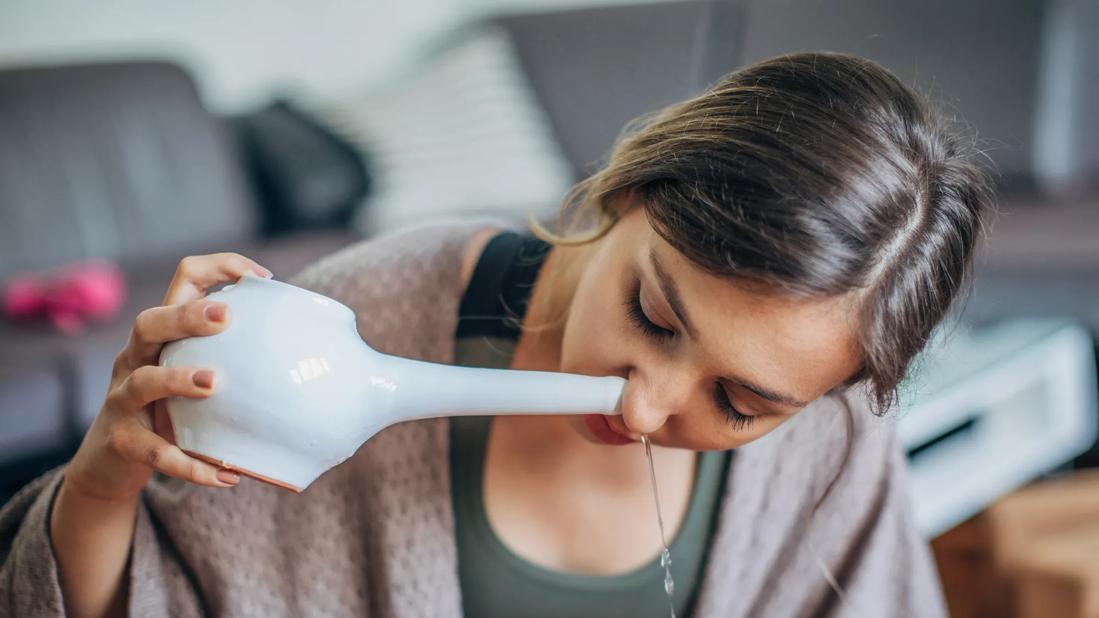Neti pots can be useful for sinus pressure relief and removing excess mucus

Using a neti pot may look silly, but these teapot-like contraptions can do wonders for nasal congestion. They’re a quick way to get relief without taking medicine. But if you don’t use neti pots correctly, you could end up making yourself feel worse.
Advertisement
Cleveland Clinic is a non-profit academic medical center. Advertising on our site helps support our mission. We do not endorse non-Cleveland Clinic products or services. Policy
Ear, nose and throat specialist Raj Sindwani, MD, explains what neti pots are, what they do and how to use one safely.
A neti pot is a device that sends a saline solution (a mixture of salt and water) through your nasal passages, clearing out built-up mucus and trapped allergens.
It may seem a bit scary, but Dr. Sindwani says using a neti pot shouldn’t hurt. As long as it’s prepared properly, the sodium in the saltwater solution will reduce inflammation and keep the delicate tissue inside your nose from getting irritated.
Neti pots are a quick and medication-free way to rinse out your nasal passage, reducing congestion and easing the discomfort of allergies, colds, sinus infections and more.
They’re beneficial because they:
These kettle-like devices may be brimming with benefits, but Dr. Sindwani recommends that you consult with a healthcare provider before using them.
Depending on your health, the risks may outweigh the benefits. For example, if you’re immunocompromised or have recently had surgery on your nose, share that information with your provider before using a neti pot.
Advertisement
If you’re using it correctly and following proper cleaning and safety advice, there are few things as refreshing as rinsing your nose out with a neti pot when you feel crummy. Dr. Sindwani breaks down the process.
There are two procedures involved in using a neti pot: preparing the saline solution and flushing out your nasal passage.
It’s common for solution packets to come with your neti pot. You can also buy them online. These are great options because they make striking the perfect balance between salt and water easy. Adding too much — or not adding enough — can cause irritation.
Dr. Sindwani recommends mixing together:
Now that you have your saline solution prepared, it’s time to team up with gravity! To start:
Take care not to bump the middle part of your nose (septum) while using the neti pot to avoid nosebleeds.
It’s important to clean and disinfect your neti pot thoroughly to avoid infections. Rinse the irrigation device after each use with filtered, distilled or boiled water.
“I recommend using hot water and antibacterial soap to clean your neti pot,” says Dr. Sindwani.
Once it’s been thoroughly cleaned, leave the device out to air-dry completely before storing it for future use.
While there are several benefits to using a neti pot, there are important tips to keep in mind to get the best possible results and prevent infection. Dr Sindwani recommends that you:
Advertisement
As the use of neti pots has grown. So has the range of nasal care tools offering similar treatments. Alternatives include:
If the idea of putting any water up your nose makes you queasy, try humidifiers and steamy showers instead. The relief they offer isn’t as impressive, but it can make nasal congestion a little easier to tolerate.
If you find yourself needing to use your neti pot a lot, it’s time to put it down — and pick up the phone.
“Stop using your neti pot if your symptoms aren’t improving, it hurts to use it or you’re showing signs of infection, like fever or vomiting,” Dr. Sindwani urges. “Those are all signs that the congestion you’re having needs medical attention.”
Advertisement
Learn more about our editorial process.
Advertisement

Yes, it’s safe for babies starting at about 9 months old and can help clear nasal mucus

They’re viral cousins, but enteroviruses are more likely to cause serious illness

This fruit has clear nutritional benefits — but there’s little evidence it can prevent or treat illness

If your nose is constantly running, it could be allergies, chronic sinusitis, nasal polyps or other concerns

Allergies, indigestion and the effects of gravity can all mess with your nose at night

Honey can help make a sore throat more bearable by tamping down inflammation and coating your throat

Honey can help relieve a cough by lowering inflammation in your airways and loosening up mucus

Changing how you breathe, gargling water and distracting yourself are all common ways to stop your diaphragm from spasming

Babies can get congested easily, but you can calm their cough by keeping them hydrated, using nasal drops and running a humidifier

Weight loss may cause loose, sagging skin and muscle loss to your rear

Several conditions, like vitiligo and fungal infection, can cause a loss of pigmentation, leading to white spots or patches on your skin